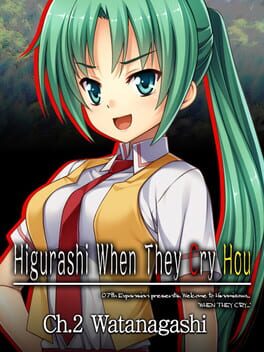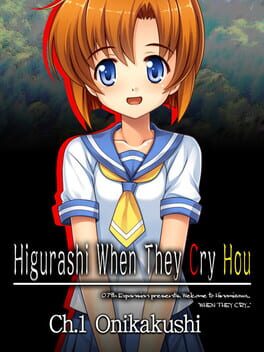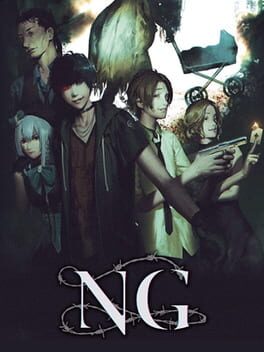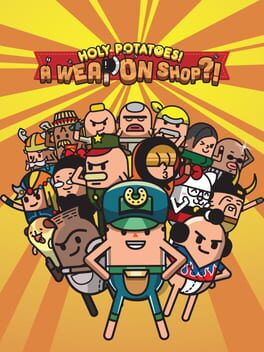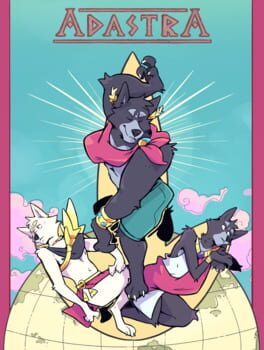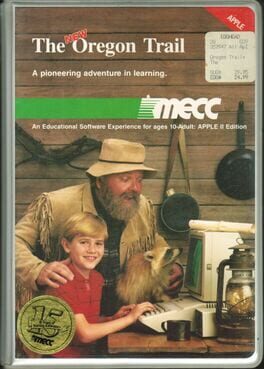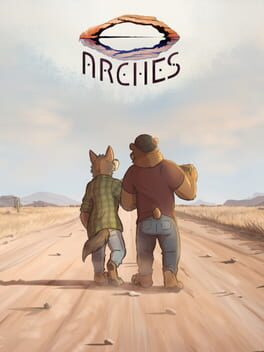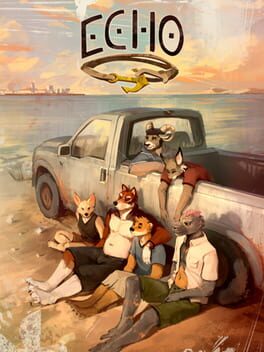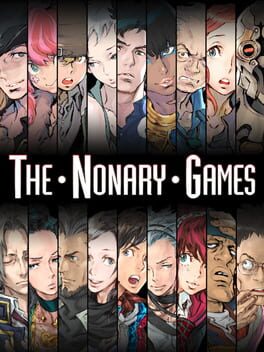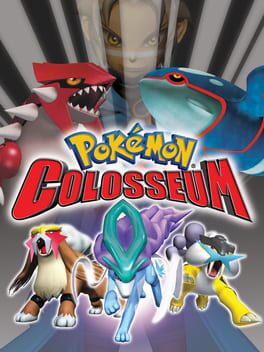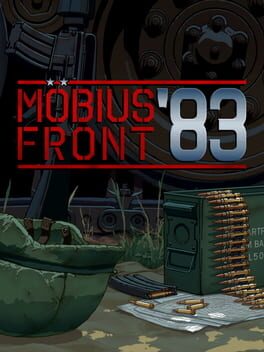kimpira
BACKER
A step up from the previous one. Some of the humor is still either a bad transcription of a comic book sight gag or else a valid pretext for a law enforcement search of the author's hard drive.
This time around there are fun little mysteries both before and after the midpoint tonal shift. The MC's transgression is also (seemingly) clearer in Watanagashi, while the others' reaction to it is surprising enough to sustain reader interest.
Before ever playing any of these, I was a little bit skeptical that a visual novel/interactive fiction game without branches was going to be worthwhile. This format allows for stories that branch without specifying a single clear point of divergence or requiring the player to fastforward through an introductory section over and over again for each branch after the first.
This time around there are fun little mysteries both before and after the midpoint tonal shift. The MC's transgression is also (seemingly) clearer in Watanagashi, while the others' reaction to it is surprising enough to sustain reader interest.
Before ever playing any of these, I was a little bit skeptical that a visual novel/interactive fiction game without branches was going to be worthwhile. This format allows for stories that branch without specifying a single clear point of divergence or requiring the player to fastforward through an introductory section over and over again for each branch after the first.
All these horror VNs I've been playing put me in the mood to revisit Higurashi for the first time since 2016.
The basic concept is still pretty sound! Start off with an idyllic little village, cross some line you weren't even aware of, and then everything nice about that small-town closeness inverts to become a potential threat.
Unfortunately, the idyllic part is tougher to get through than the horror. There's a lot of anime/manga-style exaggerated mannerisms, slapstick, etc that does not come over at all when described in text.
The basic concept is still pretty sound! Start off with an idyllic little village, cross some line you weren't even aware of, and then everything nice about that small-town closeness inverts to become a potential threat.
Unfortunately, the idyllic part is tougher to get through than the horror. There's a lot of anime/manga-style exaggerated mannerisms, slapstick, etc that does not come over at all when described in text.
2018
Refines both the gameplay and story of Death Mark.
On the gameplay front:
The timed life-or-death decisions from the previous game return here, except they've been generalized to include any potential game over situation, not just death. The game's locations are all more heavily trafficked than in Death Mark, so avoiding the notice of law enforcement is a big concern.
The battles with ghosts are still inventory puzzles, but they've dropped the need to choose an action for both the main character and their partner on every turn. They've also dropped all the redundant steps in the battles that required you to select the same defensive action over and over.
The locations all much smaller and denser, removing a lot of the back-and-forth through empty, identical rooms required by the first game.
As for story:
No more amnesia plot means we get to have an MC with a clear, distinct identity and relationships from scene 1. The side characters also have clearer reasons for their presence or absence at any given point. Your antagonist is also clear from the start! The mystery is about how to deal with her, which allows for longer-term development of her character and backstory.
On the gameplay front:
The timed life-or-death decisions from the previous game return here, except they've been generalized to include any potential game over situation, not just death. The game's locations are all more heavily trafficked than in Death Mark, so avoiding the notice of law enforcement is a big concern.
The battles with ghosts are still inventory puzzles, but they've dropped the need to choose an action for both the main character and their partner on every turn. They've also dropped all the redundant steps in the battles that required you to select the same defensive action over and over.
The locations all much smaller and denser, removing a lot of the back-and-forth through empty, identical rooms required by the first game.
As for story:
No more amnesia plot means we get to have an MC with a clear, distinct identity and relationships from scene 1. The side characters also have clearer reasons for their presence or absence at any given point. Your antagonist is also clear from the start! The mystery is about how to deal with her, which allows for longer-term development of her character and backstory.
Really nice art and memorable creature designs.
About the genre: This gets called a visual novel a lot, but it's secretly a very old-school first person point and click adventure game.
I wouldn't even call it a dungeon crawler, exactly. The mini-map shows your direction within a room, but you're not able to pivot in place and usually only a hallway or crossroads can be viewed from more than one angle.
I definitely enjoyed this as more of a monster-hunting adventure game than a horror game. It IS a horror game, but it kinda feels like the point and click stuff is at odds with the horror.
Like, Death Mark is very good about not doing anything without your input. There are clearly labeled sections where you answer life-or-death questions under a time limit, but outside of those, you're free to sit and consider your next action as long as you want. That's something I really appreciate in an adventure game, but it does kinda undermine the threatening atmosphere that horror games like to cultivate.
The need to set up puzzles for the chapter-ending confrontations also limits how detailed the game is able to get when disclosing the history of the ghosts, at least until the chapter is over. Getting the good ending for each chapter depends a lot on reading between the lines of fragmentary clues and then dealing with the ghost in a way that addresses its unique history.
About the genre: This gets called a visual novel a lot, but it's secretly a very old-school first person point and click adventure game.
I wouldn't even call it a dungeon crawler, exactly. The mini-map shows your direction within a room, but you're not able to pivot in place and usually only a hallway or crossroads can be viewed from more than one angle.
I definitely enjoyed this as more of a monster-hunting adventure game than a horror game. It IS a horror game, but it kinda feels like the point and click stuff is at odds with the horror.
Like, Death Mark is very good about not doing anything without your input. There are clearly labeled sections where you answer life-or-death questions under a time limit, but outside of those, you're free to sit and consider your next action as long as you want. That's something I really appreciate in an adventure game, but it does kinda undermine the threatening atmosphere that horror games like to cultivate.
The need to set up puzzles for the chapter-ending confrontations also limits how detailed the game is able to get when disclosing the history of the ghosts, at least until the chapter is over. Getting the good ending for each chapter depends a lot on reading between the lines of fragmentary clues and then dealing with the ghost in a way that addresses its unique history.
The first game in the Holy Potatoes series. A cute but pretty basic shop management sim. Each weapon has 4 stats: Attack, Speed, Accuracy, and Magic. Each town where you can sell items has exactly 4 pre-defined customers, each of which have a few favorite weapon types and 2 stats that they care about the most. How much they're willing to pay for an item depends on whether or not it matches these criteria.
Each of your workers in the shop have the same 4 stats, although they'll only contribute to the weapon's final stats if they're placed at the appropriate work station.
That's pretty much the whole thing! There's a thin story connecting the 4 main areas of the game. There is also, in theory, some humor, but the writing is done by people who don't do anything besides make or play video games.
Each of your workers in the shop have the same 4 stats, although they'll only contribute to the weapon's final stats if they're placed at the appropriate work station.
That's pretty much the whole thing! There's a thin story connecting the 4 main areas of the game. There is also, in theory, some humor, but the writing is done by people who don't do anything besides make or play video games.
2018
The last of the currently complete Echo Project VNs. It's still gay and still furry, but set in a different continuity and way more escapist in intent.
The art is nice, the presentation is more polished than Echo, and the writing is free of the weird phrasing/word choice problems that bring down a lot of the other Echo VNs. The final stretch of the story feels a bit filibustery, but that can probably be attributed to its patreon-based funding.
At its heart, it's a pretty standard romance novel. With all the books on smashwords/kindle unlimited called like "Claimed by the Shifter CEO," even the fact that it's a human/furry pairing doesn't place it that far out of the mainstream.
The art is nice, the presentation is more polished than Echo, and the writing is free of the weird phrasing/word choice problems that bring down a lot of the other Echo VNs. The final stretch of the story feels a bit filibustery, but that can probably be attributed to its patreon-based funding.
At its heart, it's a pretty standard romance novel. With all the books on smashwords/kindle unlimited called like "Claimed by the Shifter CEO," even the fact that it's a human/furry pairing doesn't place it that far out of the mainstream.
1985
I played this on a real Apple IIGS for the first time since maybe the early 90s. The mechanics of it feel more modern than they did back then thanks to all the indie survival games with high levels of randomness out there now.
Those are often classified as rogue-lites, but The Oregon Trail is probably much more responsible for creating an audience for permadeath survival sims than all the @ avatar text-based dungeon crawlers put together.
Those are often classified as rogue-lites, but The Oregon Trail is probably much more responsible for creating an audience for permadeath survival sims than all the @ avatar text-based dungeon crawlers put together.
2021
2018
This is a short, interactive retelling of something that appears in Echo as a reminiscence about the start of Chase's relationship with Leo. It's technically an independent story, but it relies too much on the player's familiarity with the cast and setting to really be called a standalone.
Route 65 is overall much lighter in tone than the main game. There are some elements of horror, but they're closer to being allusions to later events than active plot elements.
It has the same problems as the main game with bizarre (or sometimes just British) turns of phrase, but is saved by a lot of well-done character humor. The main character's anxieties about coming out and being seen differently by his friends and family will likely be familiar to any gay reader, even if the circumstances of their coming out don't quite match his.
Route 65 is overall much lighter in tone than the main game. There are some elements of horror, but they're closer to being allusions to later events than active plot elements.
It has the same problems as the main game with bizarre (or sometimes just British) turns of phrase, but is saved by a lot of well-done character humor. The main character's anxieties about coming out and being seen differently by his friends and family will likely be familiar to any gay reader, even if the circumstances of their coming out don't quite match his.
2015
I tried this out a few years ago and bounced off it. The setting seemed dreary and the cast kinda unpleasant. It finally clicked for me after getting an introduction to the town via the first couple of hours of The Smoke Room. I was talking to someone looking for VN recs and they said that TSR was too scary for them, so I played through it long enough to get an idea of the the series' vibe.
That was enough to return to Echo with fresh and more forgiving eyes. It paid off! The writing has problems with malapropisms, odd phrasings, occasional misspellings, and an idea of life in a hot climate that seems untouched by personal experience, but the imaginative work that the writing is doing elevates it to something special.
That was enough to return to Echo with fresh and more forgiving eyes. It paid off! The writing has problems with malapropisms, odd phrasings, occasional misspellings, and an idea of life in a hot climate that seems untouched by personal experience, but the imaginative work that the writing is doing elevates it to something special.
This review contains spoilers
I finally got around to replaying the PC releases of 999 and VLR. Roughly 10 years was just enough time to forget enough specifics to make these rewarding as both stories and puzzle-solving experiences again.
VLR in particular seems really influential in the way that it treats the player's movement through parallel timelines as an action that affects the world of the story.
VLR in particular seems really influential in the way that it treats the player's movement through parallel timelines as an action that affects the world of the story.
2003
Before starting this, I assumed that the whole game would just be the colosseum mode. I only started this up because I was trying to get the legendaries exclusive to this game for my Gen 3 Pokedex, and I was pleasantly surprised to find out that it's much more of a conventional RPG.
The gameplay is a bit rough. Everything in this game from the walk speed to the battle animations goes so slowly that I was able to play it at double speed in Dolphin with no trouble at all. I don't think I could get through all this on a real console.
Still, I'm glad that I did give this a shot. It's got some fun Y2K aesthetic elements and a pretty unique vibe for a Pokemon game. You play a fully grown adult and the setting is the Poke-verse equivalent of a low-magic world. There aren't any wild pokemon, so almost every pokemon you get beyond your starters is confiscated from other trainers that have mistreated their monsters.
The gameplay is a bit rough. Everything in this game from the walk speed to the battle animations goes so slowly that I was able to play it at double speed in Dolphin with no trouble at all. I don't think I could get through all this on a real console.
Still, I'm glad that I did give this a shot. It's got some fun Y2K aesthetic elements and a pretty unique vibe for a Pokemon game. You play a fully grown adult and the setting is the Poke-verse equivalent of a low-magic world. There aren't any wild pokemon, so almost every pokemon you get beyond your starters is confiscated from other trainers that have mistreated their monsters.
2020
The basic idea behind this game is sound but has been done better elsewhere. Build things, grow food, defend your house, etc. It feels kind of miserable to control and even small structures (like stone walls to enclose a 2x2 area) take a nearly prohibitive amount of resources to complete.
I get the impression that it's designed to encourage the use of the monkey NPCs, (during any longish crafting activity, your guy will get a thought bubble over their head that suggests having the monkeys do it) but they're kind of a pain to set up and they only make the first one easy to find.
I get the impression that it's designed to encourage the use of the monkey NPCs, (during any longish crafting activity, your guy will get a thought bubble over their head that suggests having the monkeys do it) but they're kind of a pain to set up and they only make the first one easy to find.
2021
A programming puzzle game very obviously inspired by TIS-100. It's less creative in its lore and system design, and mostly easier over-all, but it's still pretty fun if you enjoyed TIS-100.
The most obvious differences from TIS-100 are that the syntax is a bit more verbose and everything is single-threaded. The player is given many more registers over-all, but each one (except for a general use swap register) has a specific, dedicated datatype. There's even one for strings, and you can even get the length of it as a single operation. That's very un-hardware-like, but I guess you could say it's a Pascal-style string in a dont-worry-about-it length buffer.
Thanks to the typed registers, you have to care about and sometimes even use datatype coercion between registers.
So y'know, it's high level-ish. What gives it the assembly feel is mostly just the swap register and the way it breaks if-then statements into a check that sets a boolean register, followed by a conditional jump.
The most obvious differences from TIS-100 are that the syntax is a bit more verbose and everything is single-threaded. The player is given many more registers over-all, but each one (except for a general use swap register) has a specific, dedicated datatype. There's even one for strings, and you can even get the length of it as a single operation. That's very un-hardware-like, but I guess you could say it's a Pascal-style string in a dont-worry-about-it length buffer.
Thanks to the typed registers, you have to care about and sometimes even use datatype coercion between registers.
So y'know, it's high level-ish. What gives it the assembly feel is mostly just the swap register and the way it breaks if-then statements into a check that sets a boolean register, followed by a conditional jump.
2020
I like most Zachtronics games and this was part of a montly Humble Choice collection so I decided to give it a try. I was hoping that there was some sort of programming or engineering angle to it, but it really is just a turn-based strategy game set in the late 20th c. US.
I'm not rating it because I can't really give it a fair evaluation. I just couldn't make myself pay attention to it at all.
I'm not rating it because I can't really give it a fair evaluation. I just couldn't make myself pay attention to it at all.
